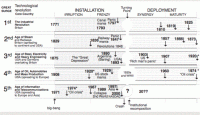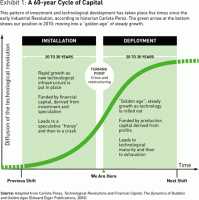As a macro econ guy, I'm naturally curious of "the big picture". I was listening to this podcast and this book, Technological Revolutions and Financial Capital: The Dynamics of Bubbles and Golden Ages, was mentioned. I haven't read it yet b/c I've been swamped with stuff, but I will.
Anyways, I did a quick search of the book and found couple things that might interest the rest of the forum, so thought I would post them.
Most of the text below comes from cdixon.org, not me.
First a chart of Tech revolutions:


If you look at the charts above you'll notice that we are currently in the "deployment" phase (2nd chart is from 2010). I started thinking about it and companies like Uber and Airbnb are beginning to utilize the technology installed during the first 30 years. This means there are abundant opportunities right now. And abundant avenues/implementations our businesses can use right now to thrive.
As followers of MJ's NCEST formula we have a tremendous advantage over traditional entrepreneurs, obviously, though, like Airbnb/UBER, etc, it requires extreme outside of the box way of thinking. Implementing new technology/ways of thinking into your business should come naturally anyways, doesn't have to be on the scale UBER currently is, but heck why not?!
The following is from cdixon.org. I think he does a great job of explaining this "deployment phase":
In the transition from installation to deployment, the bulk of the entrepreneurial activity moves “up the stack”. For example, in the installation phase of the automobile revolution, the action was in building cars. In the deployment phase, the action shifted to the app layer: the highway system, shipping, suburbanization, big box retail, etc.
This pattern is repeating itself in the computing/internet revolution. Most of the successful startups in the 90s built core infrastructure (e.g. optical switching) whereas most of the successful startups since then built applications on top of that infrastructure (e.g. search). The next phase should see startups higher in the stack. According to historical patterns, these would be ones that require deeper cultural change or deeper integration into existing industries.
- What industries are the best candidates for the next phase of deployment? The likely candidates are the information-intensive mega-industries that have been only superficially affected by the internet thus far: education, healthcare, and finance. Note that deployment doesn’t just mean creating, say, a healthcare or education app. It means refactoring an industry into its “optimal structure” – what the industry would look like if rebuilt from scratch using the new technology.
- How long will this deployment period last? Most people – at least in the tech industry – think it’s just getting started. From the inside, it looks like one big revolution with lots of smaller, internal revolutions (PC, internet, mobile, etc). Each smaller revolution extends the duration and impact of the core revolution.
- Where will this innovation take place? The historical pattern suggests it will become more geographically diffuse over time. Detroit was the main beneficiary of the first part of the automobile revolution. Lots of other places benefited from the second part. This is the main reason to be bullish on ”application layer” cities like New York and LA. It is also suggests that entrepreneurs will increasingly have multi-disciplinary expertise.
Anyways, I did a quick search of the book and found couple things that might interest the rest of the forum, so thought I would post them.
Most of the text below comes from cdixon.org, not me.
First a chart of Tech revolutions:


If you look at the charts above you'll notice that we are currently in the "deployment" phase (2nd chart is from 2010). I started thinking about it and companies like Uber and Airbnb are beginning to utilize the technology installed during the first 30 years. This means there are abundant opportunities right now. And abundant avenues/implementations our businesses can use right now to thrive.
As followers of MJ's NCEST formula we have a tremendous advantage over traditional entrepreneurs, obviously, though, like Airbnb/UBER, etc, it requires extreme outside of the box way of thinking. Implementing new technology/ways of thinking into your business should come naturally anyways, doesn't have to be on the scale UBER currently is, but heck why not?!
The following is from cdixon.org. I think he does a great job of explaining this "deployment phase":
In the transition from installation to deployment, the bulk of the entrepreneurial activity moves “up the stack”. For example, in the installation phase of the automobile revolution, the action was in building cars. In the deployment phase, the action shifted to the app layer: the highway system, shipping, suburbanization, big box retail, etc.
This pattern is repeating itself in the computing/internet revolution. Most of the successful startups in the 90s built core infrastructure (e.g. optical switching) whereas most of the successful startups since then built applications on top of that infrastructure (e.g. search). The next phase should see startups higher in the stack. According to historical patterns, these would be ones that require deeper cultural change or deeper integration into existing industries.
- What industries are the best candidates for the next phase of deployment? The likely candidates are the information-intensive mega-industries that have been only superficially affected by the internet thus far: education, healthcare, and finance. Note that deployment doesn’t just mean creating, say, a healthcare or education app. It means refactoring an industry into its “optimal structure” – what the industry would look like if rebuilt from scratch using the new technology.
- How long will this deployment period last? Most people – at least in the tech industry – think it’s just getting started. From the inside, it looks like one big revolution with lots of smaller, internal revolutions (PC, internet, mobile, etc). Each smaller revolution extends the duration and impact of the core revolution.
- Where will this innovation take place? The historical pattern suggests it will become more geographically diffuse over time. Detroit was the main beneficiary of the first part of the automobile revolution. Lots of other places benefited from the second part. This is the main reason to be bullish on ”application layer” cities like New York and LA. It is also suggests that entrepreneurs will increasingly have multi-disciplinary expertise.
Dislike ads? Remove them and support the forum:
Subscribe to Fastlane Insiders.
Last edited:
